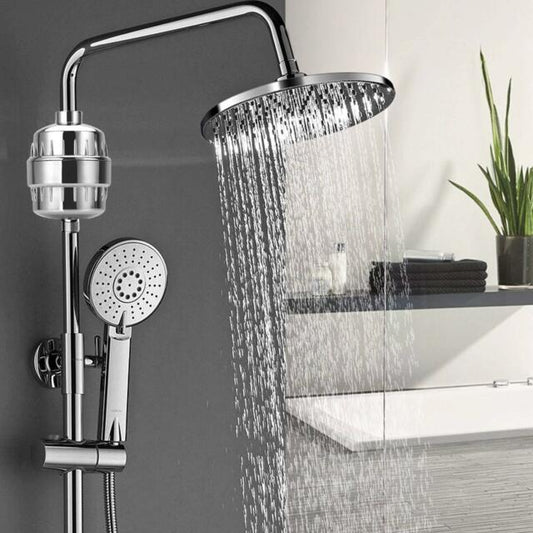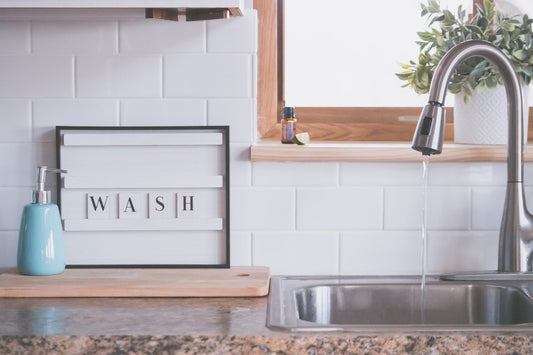What is template assisted crystallization? Does it even work? Is there any research out there to show that it’s better or worse than any other water softeners or water conditioners?
Template Assisted Crystallization: A Quick Breakdown
Water softeners can be extremely complicated, but in this article we’ll try to explain to you how FilterSmart systems work using template assisted crystallization, or nucleation assisted crystallization.
“Nano crystals,” “nucleation sites,” “polymeric beads” -- it’s all way more confusing than it really has to be, so we’re going to start with a simple explanation (kind of like in the same language that “Simple English Wikipedia” would use, or as close to it as possible) before we dive into the more in-depth explanation.
A Simple Way to Understand TAC
Hard water is made up of magnesium and calcium. Magnesium and calcium form limescale, the pesky whitespots you see on your glasses and the chalky build-up on your showerheads and in your sink. If you’re looking for a water softener, that’s the stuff you’re trying to get rid of.
TAC changes the structure of magnesium and calcium so that it won’t stick to your glasses, showerheads, pipes, and sink. It does this by having the magnesium and calcium interact with a media bed prior to flowing through your pipes.
Here’s a metaphor that might help: imagine that your pipes are lined with duct tape. The small bits of magnesium and calcium are going to stick to the duct tape, right? As long as the magnesium and calcium touches the tape, it’s gonna stick. When magnesium and calcium interact with the TAC media, though, they form micro crystals that remain suspended in the water, never interacting with the tape.
Here’s a diagram that might make it more clear:
What’s the Alternative?
The most popular alternative to template assisted crystallization is ion exchange. Ion exchange water softeners work by reducing the amount of magnesium and calcium in your water, replacing it with sodium.
The downsides are numerous:
-
your drinking water is now filled with sodium instead of naturally occuring spring-like minerals (magnesium and calcium).
-
You have to buy a new bag of salt every few weeks, and you have to keep refilling the softener.
-
your water softener has to undergo a regeneration cycle every few days to rinse the magnesium and calcium off of the resin (producing a bunch of waste water).
-
You need electricity to power the regeneration cycle, further complicating installation and introducing more maintenance issues.
Why Template Assisted Crystallization “Doesn’t Work.”
Ion exchange water softening companies will use this process -- ion exchange -- as the reason why template assisted crystallization “doesn’t work.” And are they right?
Does template assisted crystallization even work? It all sounds fancy and confusing, full of industry jargon that you seemingly need a Master’s degree in hydrology to fully understand.
Ion exchange companies argue that template assisted crystallization is essentially a pseudoscience because it doesn’t actually remove hardness ions like magnesium and calcium. It’s an anti-scaling system, not a “true” water softener. When you first start researching water softeners, you might buy a hardness testing strip to see if you have hard water. This determines the grains per gallon of hardness present in your water. That way you can know how serious your hard water problem really is.
When you use an ion exchange softener, the grains per gallon is going to disappear. The water hardness testing strip will show that there’s no magnesium and calcium left. The process replaced it with sodium.
What happens when you use a template assisted crystallization water softener, though? Since the media bed only changes the structure of magnesium and calcium so that they remain suspended in the water, the testing strip is going to show the same amount of “hardness.”
However, the downsides of hard water aren’t magnesium and calcium, it’s limescale build-up. It’s not that you need to get rid of magnesium and calcium, you need to get rid of limescale. Template assisted crystallization specifically targets limescale build-up.
That way you don’t need to:
-
Get rid of healthy spring-like minerals in your water.
-
Generate a ton of wastewater every regeneration cycle.
-
Buy salt replacements regularly.
The real issue is that salt-based water softening companies conflate template assisted crystallization to be the same thing as magnetic water conditioning. We’ve written about the research regarding magnetic conditioning in the past. Both are anti scaling water systems, but TAC and magnetic conditioning are very, very different. Just because a water softener uses no salt doesn’t mean that it uses electromagnetic conditioning instead.
Where’s the Research on TAC NAC and salt-free softeners?
The University of Arizona performed a research review on the effects of domestic alternatives to ion exchange water softening. Researchers and scientists across the world are working hard to find out how to replace ion exchange as the principal method of water softening. Why? For a lot of the reasons we mentioned above: because it’s bad for the environment. Not only is salt a nonrenewable resource, but also, during the process of regeneration, ion exchange systems pour tons of wastewater back into the environment. Ion exchange systems go through this process every few days or so.
They found that template assisted crystallization is extremely effective at reducing limescale build-up:
In short, if TAC gets rid of limescale and ion exchange gets rid of limescale, they both largely have the same purpose.
Conclusion: Yes, Template Assisted Crystallization Works
So, does template assisted crystallization work? Of course, it does.
Nucleation assisted crystallization works by changing the way that magnesium and calcium interact with surfaces. Magnesium and calcium form micro-crystals that remain suspended in water, not adhering to surfaces. Third-party research has confirmed their efficacy. They don’t generate wastewater and they don’t use nonrenewable resources.
The problem occurs when you use the wrong metric to determine whether or not TAC is effective. You don’t need to actually get rid of hard water, you need to get rid of limescale. A hard water testing strip will show that there is still magnesium and calcium in your water, but the University of Arizona confirms that it successfully reduces limescale.
Questions? Concerns? Feel free to get in touch:
Call us: 866.455.9989
Email us: sales@filtersmart.com








